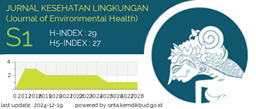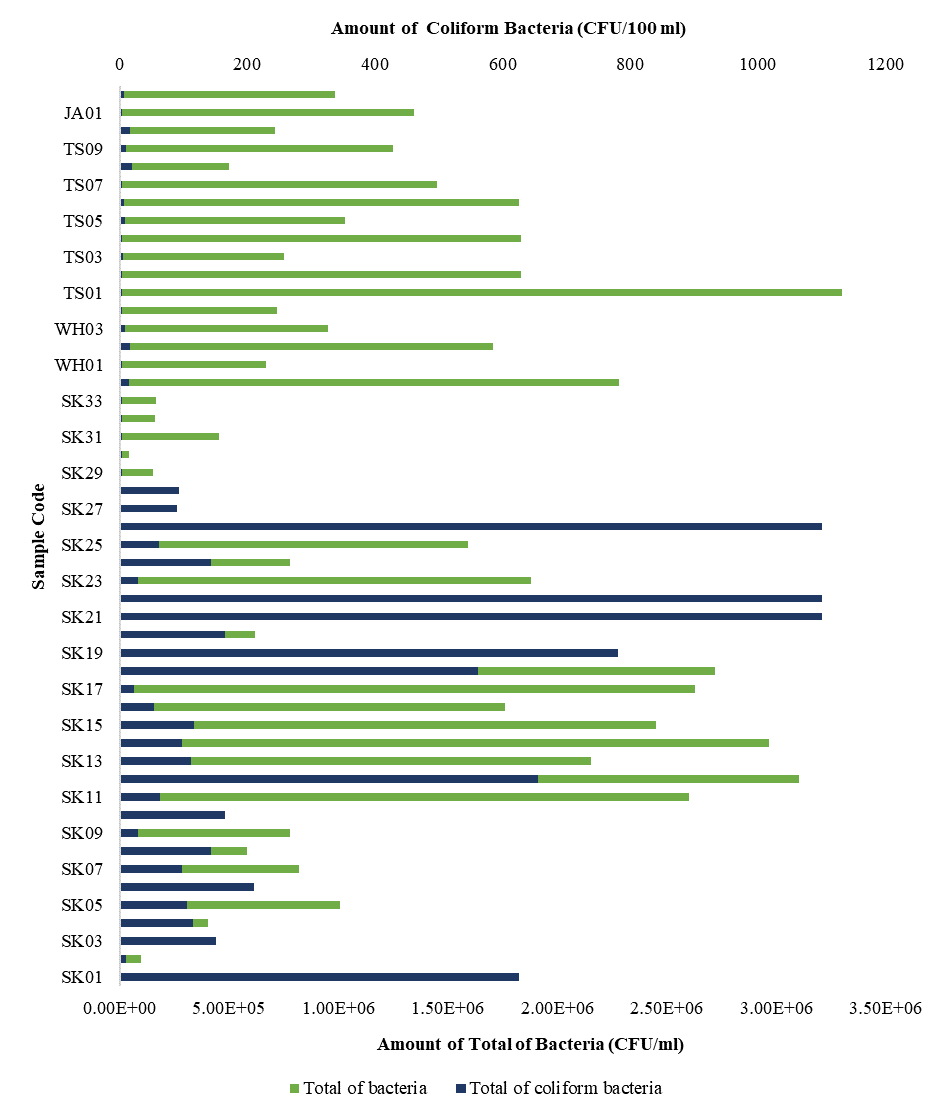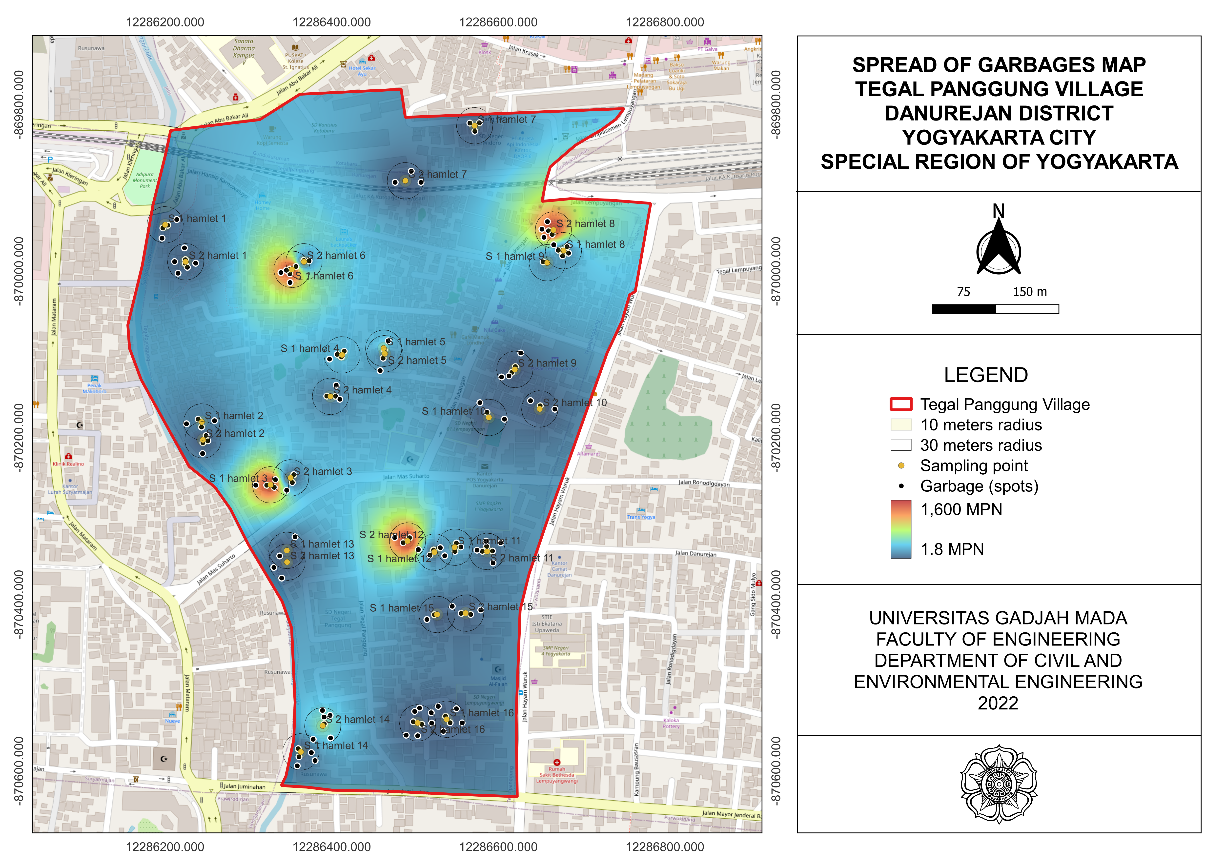Distribution and Abundance of Microplastics in Underground Rivers in the South Malang Karst Area: First Evidence in Indonesia

Introduction: The presence of microplastics in the environment increases the diversity of types of pollutants in waters, including clean water sources on the surface and underground. Karst areas have unique hydrological characteristics, with cracks and fissures between the rocks that can be potential routes for the transport and accumulation of microplastics in underground river flows. In this study, we want to know the distribution and abundance of microplastics in underground rivers in the karst area of South Malang, Indonesia.
Methods: Samples were collected purposively from underground river of Lowo, Banyu and Sengik. Microplastics were prepared using a diluted solvent of 30% H2SO4 and 30% H2O2. The sediment sample was dried and then filtered twice using 300-mesh size nylon filters until microplastic particles accumulated.
Results and Discussion: Microplastics were detected in all water samples, with an average abundance ranging from 1.8 to 2.3 particles per liter. Fibers were the dominant microplastic type, followed by fragments and films, while the color distribution includes blue, white, red, yellow, black, green, pink, and brown.
Conclusion: Microplastic contamination has been found in underground river flows in the karst area of South Malang, Indonesia. Karst soil, traditionally viewed as a natural filter, is not impervious to plastic pollution. This suggests significantly higher surface contamination than previously assumed. Therefore, reducing surface pollution is essential to safeguard the precious quality of underground aquifers and protect public health above.
United Nations Development Programme. Goal 6: Clean Water and Sanitation Sustainable Development Goals. New York: United Nations Development Programme; 2023. https://www.undp.org/sustainable-development-goals/clean-water-and-sanitation
Mendoza LMR, Balcer M. Microplastics in Freshwater Environments. In: Encyclopedia of the World's Biomes. United States: Elsevier; 2020. p. 325–553. https://doi.org/10.1016/B978-0-12-409548-9.12394-2
Jambeck JR, Geyer R, Wilcox C, Siegler TR, Perryman M, Andrady A, et al. Plastic Waste Inputs from Land into the Ocean. Science. 2015;347(6223):768–771. https://doi.org/10.1126/science.1260352
Horton AA, Barnes DKA. Microplastic Pollution in a Rapidly Changing World: Implications for Remote and Vulnerable Marine Ecosystems. Sci Total Environ. 2020;738(140349):1-9. https://doi.org/10.1016/j.scitotenv.2020.140349
Hoffmann L, Eggers SL, Allhusen E, Katlein C, Peeken I. Interactions between the Ice Algae Fragillariopsis Cylindrus and Microplastics in Sea Ice. Environ Int. 2020;139(10569):1-9. https://doi.org/10.1016/j.envint.2020.105697
Rui-ping L, Ying D, Guo-cang Q, Hua Z, You-ning X, Elwardany RM. Microplastic Pollution in Surface Water and Sediments of Qinghai-Tibet Plateau: Current Status and Causes. China Geol. 2021;4(1):178–184. https://doi.org/10.31035/cg2021011
Balestra V, Bellopede R. Microplastic Pollution in Show Cave Sediments: First Evidence and Detection Technique. Environ Pollut. 2022;292(118261):1-9. https://doi.org/10.1016/j.envpol.2021.118261
Beynen PV, Brinkmann R, Beynen KV. A Sustainability Index for Karst Environments. J Cave Karst Stud. 2012;74(2):221–234. https://doi.org/10.4311/2011SS0217
Ministry of Energy and Mineral Resources of Republic Indonesia. Kegeologian. Jakarta: Ministry of Energy and Mineral Resources of Republic Indonesia; 2023. https://geoportal.esdm.go.id/geologi/
Campanale C, Galafassi S, Savino I, Massarelli C, Ancona V, Volta P, et al. Microplastics Pollution in the Terrestrial Environments: Poorly Known Diffuse Sources and Implications for Plants. Sci Total Environ. 2022;805(150431):1-15. https://doi.org/10.1016/j.scitotenv.2021.150431
Jenner LC, Rotchell JM, Bennett RT, Cowen M, Tentzeris V, Sadofsky LR. Detection of Microplastics in Human Lung Tissue using μFTIR spectroscopy. Sci Total Environ. 2022;831(154907):1-10. https://doi.org/10.1016/j.scitotenv.2022.154907
Saha SC, Saha G. Effect of Microplastics Deposition on Human Lung Airways: A Review with Computational Benefits and Challenges. Heliyon. 2024;10(2):e24355. https://doi.org/10.1016/j.heliyon.2024.e24355
Montano L, Giorgini E, Notarstefano V, Notari T, Ricciardi M, Piscopo M, et al. Raman Microspectroscopy Evidence of Microplastics in Human Semen. Sci Total Environ. 2023;901(165922):1-10. https://doi.org/10.1016/j.scitotenv.2023.165922
Weingrill RB, Lee MJ, Benny P, Riel J, Saiki K, Garcia J, et al. Temporal Trends in Microplastic Accumulation in Placentas from Pregnancies in Hawai. Environ Int. 2023;180(108220):1-7. https://doi.org/10.1016/j.envint.2023.108220
Central Beureu of Statistic of East Java. Jumlah Jenis Penyakit Tetanus, Campak, Diare, DBD, IMS Menurut Kabupaten/Kota di Provinsi Jawa Timur. BPS.go.id. Jakarta: Central Beureu of Statistic of East Java; 2023. https://jatim.bps.go.id/statictable/2023/07/24/2975/-jumlah-jenis-penyakit-tetanus-campak-diare-dbd-ims-menurut-kabupaten-kota-di-provinsi-jawa-timur-2022.html
Haribowo R, Rubiantoro P, Fadhilah A, Denindya ZAP, Kristanti YA, Rismiati W, et al. Assessment of Small-Scale Microplastics Abundance and Characterization in Urban River: A Case Study in Metro River, Indonesia. J Eng Technol Sci. 2023;55(2):167–176. https://doi.org/10.5614/j.eng.technol.sci.2023.55.2.6
Alam FC, Sembiring E, Muntalif BS, Suendo V. Microplastic Distribution in Surface Water and Sediment River Around Slum and Industrial Area (Case Study: Ciwalengke River, Majalaya District, Indonesia). Chemosphere. 2019;224(1):637–645. https://doi.org/10.1016/j.chemosphere.2019.02.188
Yona D, Sari SHJ, Iranawati F, Bachri S, Ayuningtyas WC. Microplastics in the Surface Sediments from the Eastern Waters of Java Sea, Indonesia. F1000Research. 2019;8(98):1-14. https://f1000research.com/articles/8-98/v1
Lozano YM, Lehnert T, Linck LT, Lehmann A, Rillig MC. Microplastic Shape, Polymer Type, and Concentration Affect Soil Properties and Plant Biomass. Front Plant Sci. 2021;12(616645):1-12. https://doi.org/10.3389/fpls.2021.616645
Vivekanand AC, Mohapatra S, Tyagi VK. Microplastics in Aquatic Environment: Challenges and Perspectives. Chemosphere. 2021;282(131151):1-14. https://doi.org/10.1016/j.chemosphere.2021.131151
Financial and Development Supervisory Board of Malang. Perwakilan Provinsi Jawa Timur. Malang: Financial and Development Supervisory Board of Malang; 2024. https://jatim.bpk.go.id/kabupaten-malang/
Zhao X, Wang J, Yee Leung KM, Wu F. Color: An Important but Overlooked Factor for Plastic Photoaging and Microplastic Formation. Environ Sci Technol. 2022;56(13):9161–9163. https://doi.org/10.1021/acs.est.2c02402
Stoorvogel J. Residual Plastic in Banana Plantation Soils: A Case Study of Costa Rica. Thesis. Wageningen: Wageningen University and Research; 2023. https://edepot.wur.nl/643030
Zhang Z, Zhang F, Yang X, Zhang J. The Occurrence and Distributions Characteristics of Microplastics in Soils of Different Land Use Patterns in Karst Plateau, Southwest China. Sci Total Environ. 2024;906(167651):1-10. https://doi.org/10.1016/j.scitotenv.2023.167651
MatjaÅ¡iÄ T, Mori N, Hostnik I, Bajt O, KovaÄ VirÅ¡ek M. Microplastic Pollution in Small Rivers Along Rural–Urban Gradients: Variations Across Catchments and Between Water Column and Sediments. Sci Total Environ. 2023;858(160043):1-11. https://doi.org/10.1016/j.scitotenv.2022.160043
Jeong E, Kim YI, Lee JY, Raza M. Microplastic Contamination in Groundwater of Rural Area, Eastern Part of Korea. Sci Total Environ. 2023;895(165006):1-11. https://doi.org/10.1016/j.scitotenv.2023.165006
Shu X, Xu L, Yang M, Qin Z, Zhang Q, Zhang L. Spatial Distribution Characteristics and Migration of Microplastics in Surface Water, Groundwater and Sediment in Karst Areas: The Case of Yulong River in Guilin, Southwest China. Sci Total Environ. 2023;868(161578):1-11. https://doi.org/10.1016/j.scitotenv.2023.161578
Romano E, Bergamin L, Di Bella L, Baini M, Berto D, D'Ambrosi A, et al. First Record of Microplastic in the Environmental Matrices of a Mediterranean Marine Cave (Bue Marino, Sardinia, Italy). Mar Pollut Bull. 2023;186(114452):1-12. https://doi.org/10.1016/j.marpolbul.2022.114452
Tursi A, Baratta M, Easton T, Chatzisymeon E, Chidichimo F, De Biase M, et al. Microplastics in Aquatic Systems, A Comprehensive Review: Origination, Accumulation, Impact, and Removal Technologies. RSC Adv. 2022;12(44):28318–28340. https://doi.org/10.1039/D2RA04713F
Earle S. 12.3 Karst Hydrogeology. Kamloops: Thompson Rivers University; 2023. https://environmental-geology-dev.pressbooks.tru.ca/chapter/karst-hydrogeology/
Agbekpornu P, Kevudo I. The Risks of Microplastic Pollution in the Aquatic Ecosystem. In: Salama ES, editor. Advances and Challenges in Microplastics. Rijeka: IntechOpen; 2023. https://doi.org/10.5772/intechopen.108717
Waldschläger K, Brückner MZM, Almroth BC, Hackney CR, Adyel TM, Alimi OS, et al. Learning from Natural Sediments to Tackle Microplastics Challenges: A Multidisciplinary Perspective. Earth-Sci Rev. 2022;228(104021):1-24. https://linkinghub.elsevier.com/retrieve/pii/S0012825222001052
Luo Z, Lian J, Nie Y, Zhang W, Wang F, Huang L, et al. Improving Soil Thickness Estimations and Its Spatial Pattern on Hillslopes in Karst Forests Along Latitudinal Gradients. Geoderma. 2024;441(116749):1-9. https://doi.org/10.1016/j.geoderma.2023.116749
Lange K, Magnusson K, Viklander M, Blecken GT. Removal of Rubber, Bitumen and Other Microplastic Particles from Stormwater by A Gross Pollutant Trap - Bioretention Treatment Train. Water Res. 2021;202(117457):1-9. https://doi.org/10.1016/j.watres.2021.117457
Febriani IS, Amin B, Fauzi M. Distribusi Mikroplastik di Perairan Pulau Bengkalis Kabupaten Bengkalis Provinsi Riau. Depik. 2020;9(3):386–392. https://doi.org/10.13170/depik.9.3.17387
Henry B, Laitala K, Klepp IG. Microfibres from Apparel and Home Textiles: Prospects for Including Microplastics in Environmental Sustainability Assessment. Sci Total Environ. 2019;652(1):483–494. https://doi.org/10.1016/j.scitotenv.2018.10.166
Dolar A, Selonen S, Van Gestel CAM, Perc V, Drobne D, Kokalj AJ. Microplastics, Chlorpyrifos and Their Mixtures Modulate Immune Processes in the Terrestrial Crustacean Porcellio scaber. Sci Total Environ. 2021;772(144900):1-11. https://doi.org/10.1016/j.scitotenv.2020.144900
Wang Y, Xu X, Jiang G. Microplastics Exposure Promotes the Proliferation of Skin Cancer Cells But Inhibits the Growth of Normal Skin Cells by Regulating the Inflammatory Process. Ecotoxicol Environ Saf. 2023;267(115636):1-10. https://doi.org/10.1016/j.ecoenv.2023.115636
Zhang P, Zhang Y, Li P, Tu D, Zheng X. Effects of the Adsorption Behavior of Polyamide Microplastics on Male Reproductive Health by Reduction of Testosterone Bioavailability. Ecotoxicol Environ Saf. 2024;269(115747):1-13. https://doi.org/10.1016/j.ecoenv.2023.115747
Moshood TD, Nawanir G, Mahmud F, Mohamad F, Ahmad MH, AbdulGhani A. Biodegradable Plastic Applications Towards Sustainability: A Recent Innovations in the Green Product. Clean Eng Technol. 2022;6(100404):1-14. https://doi.org/10.1016/j.clet.2022.100404
Hiwari H, Purba NP, Ihsan YN, Yuliadi LPS, Mulyani PG. Kondisi Sampah Mikroplastik di Permukaan Air Laut Sekitar Kupang dan Rote, Provinsi Nusa Tenggara Timur. JSAL. 2019;8(2):74-84. https://doi.org/10.21776/ub.jsal.2021.008.02.3
Volent Z, Birkevold J, Stahl A, Lien A, Sunde LM, Lader P. Experimental Study of Installation Procedure and Volume Estimation of Tarpaulin for Chemical Treatment of Fish in Floating Cages. Aquac Eng. 2017;78(1):105–113. https://doi.org/10.1016/j.aquaeng.2017.05.003
Rossatto A, Arlindo MZF, De Morais MS, De Souza TD, Ogrodowski CS. Microplastics in Aquatic Systems: A Review of Occurrence, Monitoring and Potential Environmental Risks. Environ Adv. 2023;13(100396):1-19. https://doi.org/10.1016/j.envadv.2023.100396
Hasenmueller EA, Baraza T, Hernandez NF, Finegan CR. Cave Sediment Sequesters Anthropogenic Microparticles (Including Microplastics and Modified Cellulose) in Subsurface Environments. Sci Total Environ. 2023;893(164690):1-13. https://doi.org/10.1016/j.scitotenv.2023.164690
Nesterovschi I, Marica I, Levei EA, Angyus SB, Kenesz M, Moldovan OT, et al. Subterranean Transport of Microplastics as Evidenced in Karst Springs and Their Characterization Using Raman Spectroscopy. Spectrochim Acta A Mol Biomol Spectrosc. 2023;298(122811):1-12. https://doi.org/10.1016/j.saa.2023.122811
Balestra V, Vigna B, De Costanzo S, Bellopede R. Preliminary Investigations of Microplastic Pollution in Karst Systems, from Surface Watercourses to Cave Waters. J Contam Hydrol. 2023;252(104117):1-10. https://doi.org/10.1016/j.jconhyd.2022.104117
He K, Wang J, Chen Q, Wu F, Yang X, Chen J. Effects of Cascade Dams on the Occurrence and Distribution of Microplastics in Surface Sediments of Wujiang River Basin, Southwestern China. Ecotoxicol Environ Saf. 2022;240(113715):1-8. https://doi.org/10.1016/j.ecoenv.2022.113715
Esfandiari A, Abbasi S, Peely AB, Mowla D, Ghanbarian MA, Oleszczuk P, et al. Distribution and Transport of Microplastics in Groundwater (Shiraz aquifer, Southwest Iran). Water Res. 2022;220(118622):1-9. https://doi.org/10.1016/j.watres.2022.118622

This work is licensed under a Creative Commons Attribution-NonCommercial-ShareAlike 4.0 International License.
1. Copyright of all journal manuscripts is held by the Jurnal Kesehatan Lingkungan.2. Formal legal provisions to access digital articles of electronic journal are subject to the provision of the Creative Commons Attribution-ShareAlike license (CC BY-NC-SA), which means that Jurnal Kesehatan Lingkungan is rightful to keep, transfer media/format, manage in the form of databases, maintain, and publish articles.
3. Published manuscripts both printed and electronic are open access for educational, research, and library purposes. Additionally, the editorial board is not responsible for any violations of copyright law.
JKESLING by UNAIR is licensed under a Creative Commons Attribution-ShareAlike 4.0 International License.







































